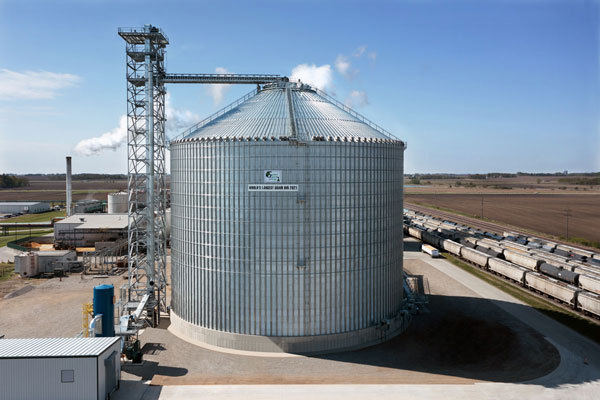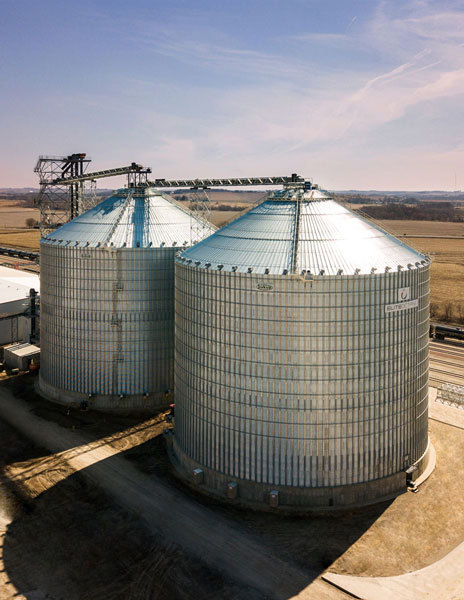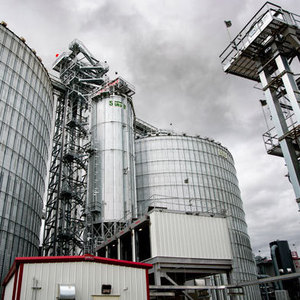Grain Storage On The Grow




PHOTO: SUKUP MANUFACTURING CO.
November 10, 2021
BY Tom Bryan
FROM THE DECEMBER 2021 ISSUE
With this year’s corn crop expected to top 15 billion bushels—the second largest harvest in history—and Iowa alone surpassing 2.5 billion bushels, another wave of grain storage expansion may be on the horizon in the Corn Belt, despite high steel prices and longer project wait times.
Such bumper crops amplify the need for more grain storage and, when prices are good, create an economic windfall that trickles over to on-farm and industrial improvements like grain storage. Farmers benefit from added grain storage by being able to hold onto their grain until prices are optimal. Likewise, ethanol plants upsize their storage for enhanced flexibility and control.
“For ethanol producers, more storage is often an easy financial decision,” says Brent Hansen, commercial accounts manager at Iowa-based Sukup Manufacturing Co. “Grain bins are among the quickest-payback investments producers can make. If they can capture grain fresh out of the field near the end of the year, that’s about the best price they may see. Any volume you can get right away is going to typically help your margins.”
Hansen explains that producers also benefit from enhanced grain storage in the spring when growers are planting and unable to deliver their stored grain to the plant. “It’s not only about being able to accept that new grain in the fall,” he says, “but also having capacity to keep enough on hand to maintain control in the spring.”
When the majority of U.S. ethanol plants were built 10 to 15 years ago, most were 50 to 80 MMgy and sized their grain storage for 10 to 12 days of production. Anything above half a million bushels of storage was adequate. “Whether it was for cost reduction or other reasons, most ethanol plants were built with a minimum amount of grain storage on site,” Hansen says. “They just didn’t see the advantage of going real big. It’s a different story now.”
Today, ethanol plant grain storage varies widely, but most producers have, or want, at least 20 days of capacity. “A lot of them would like to be at 30 or even 60 days depending on location,” Hansen says. “The advantage they get with larger bins, whether it’s a 1-, 1.5-, 2- or 2.5-million-bushell bin, is getting substantially more storage on a smaller footprint than was previously possible.”
Space isn’t an issue for all producers, of course, but Hansen says even those with multi-acre sites can benefit from the scale and efficiency of an extra-large grain bin. “The ethanol industry is going bigger these days because they’re just turning so much grain,” Hansen says. “With the smaller ethanol plants of the past, and the truck elevators, anything over 1 million bushels was considered pretty substantial because they didn’t always have the capability to monitor large amounts of incoming grain; it was risky.”
Now, with a third of U.S. ethanol plants over 100 MMgy, all having sophisticated procurement strategies, high-speed receiving and monitoring capabilities, grain storage strategies have changed. Sukup, which has delivered grain storage and receiving infrastructure to as many as 50 U.S. ethanol plants, made headlines earlier this year for building the world’s largest free-span grain bin. The container, built for Golden Grain Energy (GGE) in Mason City, Iowa, has a remarkable 165-foot diameter and a peak height of 144 feet. The massive bin, dubbed “Binzilla,” holds 2.2 million bushels of corn, and according to GGE CEO Chad Kuhlers, the system has increased the 127 MMgy plant’s grain storage from about 1.275 million bushels to almost 3.5 million bushels. Kuhlers said GGE went from about 10 days of storage to 30.
GGE grinds about 130,000 bushels of corn per day, or 42 million bushels annually. The added capacity has increased the plant’s efficiency and bolstered its corn-buying flexibility, allowing GGE to better bridge times when farmers and elevators aren't shipping corn, such as holidays or during bad weather. Notably, GGE increased its receiving capacity from 40,000 bushels per hour to 65,000 bushels per hour.
Other big Sukup projects in recent years include Homeland Energy in Lawler, Iowa, Elite Octane in Atlantic, Iowa, Ringneck Energy in Onida, South Dakota, and a former Flint Hills Resources plant in Menlo, Iowa, now owned by POET. Sukup manufactured massive bins at each location and, for Homeland, Ringneck and POET-Menlo provided its complete package including elevators, grain bins, buildings and conveyers, along with support structures.
Following completion of the Ringneck project, Steve Sukup, vice-president and chief financial officer of Sukup and a member of Ringneck’s board of directors, said the job was the largest single-site deployment of Sukup equipment in number of pieces and dollar value. “As a company we’ve been expanding our commercial-scale material handling equipment offerings for the past several years,” he said. “This project really pulls it all together in a way that shows we can equip big commercial projects with the grain storage and handling equipment they need.”
With its headquarters in Sheffield, Iowa, a steel coil facility 30 minutes to the north in Manly and manufacturing 15 minutes to south in Hampton, Sukup is the largest family-owned and operated grain bin manufacturer in the world. The components of its bins are manufactured in Iowa and constructed by a network of builder-distributors across the country. In fact, Sukup grain bins can be found all over the world.
The company was started in 1963 by Eugene Sukup and, like the ethanol industry, has continuously redefined itself through innovation. Sukup is known for innovations such as its patented double-ended stud bolt, which mitigates moisture problems. Sukup was also the first company to use bolts with a better coating to prevent rust, as well as sidewall splice plates that allow laminated sidewall sheets to be connected end-to-end instead of overlapped. The plates simplify construction and provide for a more watertight bin than using the traditional method of overlapping sheets. The company also offers wider bin decks for enhanced safety. Larger bins also require enhanced structural support and roof capacities. “We’re building the largest of them with 150,000-pound roof capacities” Hansen says.
These and other innovations have kept Sukup busy with new projects in the ethanol industry, and Hansen expects an influx of new commercial orders in 2022, despite the high cost of steel.
With the price of sheet steel at nearly $2,000 a ton, two to three times its pre-pandemic price, the cost of corrugated steel grain bins has, in fact, risen. But Hansen says that hasn’t necessarily deterred ethanol producers from moving forward with projects.
“It does present challenges,” Hansen says. “You’re looking at double or even triple the cost with some steel. Whether its coiled or tube steel. The supply chain has also been tight at times, and we have done everything we can to keep things moving. Labor has also been an issue—everyone is looking for employees.”
While the steel industry is working to bring both existing and new capacity online, the price of steel—and everything made from it—is expected to remain high for some time. “We have a lot of interest for next year, but we’re not seeing all these issues being completely resolved by spring,” Hansen says.
“Lead time is longer than normal. It’s been that kind of year for everyone. This situation is not unique to our company, our distributors, or the grain storage industry. Everyone is feeling these price and supply chain issues—whether you’re buying a couch, a truck or a grain bin—and it’s hard to say when it will ease up.”
Hansen adds, “Costs may be up, but ethanol production is in a good place. We support ethanol, we truly believe in it, and we remain ready to serve producers whenever they need us.”
Author: Tom Bryan
Contact: editor@bbiinternational.com
Advertisement
Advertisement
Advertisement
Advertisement
Related Stories
Avfuel Corp., the leading independent supplier of aviation fuel and services, is expanding its sustainable aviation fuel (SAF) footprint with the addition of a new, strategic supply point in Denver, Colorado—the first of its kind in the region.
CVR Energy Inc. on July 30 reported its renewables segment achieved increased throughput during Q2 despite unplanned downtime but reported a net loss of $11 million. The company expects to retroactively claim the 45Z credit for volumes produced.
Total U.S. operable biofuels production capacity expanded in May, with gains for renewable diesel and a small decrease for ethanol, according to data released by the U.S. Energy Information Administration. Feedstock consumption was up.
SAF-producer XCF Global Inc. on July 28 announced it has signed an exclusive, non-binding indication of intent (IOI) with a renewable fuels infrastructure and feedstock solutions company based in the western U.S.
The abrupt closure announcement by Biox Corp. is the latest example of a failure to secure Canada's domestic energy supply, says Unifor. The Canadian energy union is advocating for simply regulatory changes that could help restart the facility.
Upcoming Events










